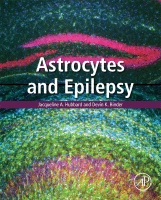Browse content
Table of contents
Actions for selected chapters
- Full text access
- Book chapterAbstract only
Chapter 1 - History of Astrocytes
Pages 1-38 - Book chapterAbstract only
Chapter 2 - Astrocytes in the Mammalian Brain
Pages 39-51 - Book chapterAbstract only
Chapter 3 - Gliotransmitters
Pages 53-73 - Book chapterAbstract only
Chapter 4 - Types of Epilepsy
Pages 75-92 - Book chapterAbstract only
Chapter 5 - Neuropathology of Human Epilepsy
Pages 93-124 - Book chapterAbstract only
Chapter 6 - Astrocyte Calcium Signaling
Pages 125-145 - Book chapterAbstract only
Chapter 7 - Potassium Channels
Pages 147-169 - Book chapterAbstract only
Chapter 8 - Water Channels
Pages 171-195 - Book chapterAbstract only
Chapter 9 - Glutamate Metabolism
Pages 197-224 - Book chapterAbstract only
Chapter 10 - Adenosine Metabolism
Pages 225-263 - Book chapterAbstract only
Chapter 11 - Gap Junctions
Pages 265-289 - Book chapterAbstract only
Chapter 12 - Blood–Brain Barrier Disruption
Pages 291-311 - Book chapterAbstract only
Chapter 13 - Inflammation
Pages 313-342 - Book chapterAbstract only
Chapter 14 - Therapeutic Targets and Future Directions
Pages 343-366 - Book chapterNo access
Index
Pages 367-381
About the book
Description
Epilepsy is a devastating group of neurological disorders characterized by periodic and unpredictable seizure activity in the brain. There is a critical need for new drugs and approaches given than at least one-third of all epilepsy patients are not made free of seizures by existing medications and become "medically refractory". Much of epilepsy research has focused on neuronal therapeutic targets, but current antiepileptic drugs often cause severe cognitive, developmental, and behavioral side effects. Recent findings indicate a critical contribution of astrocytes, star-shaped glial cells in the brain, to neuronal and network excitability and seizure activity. Furthermore, many important cellular and molecular changes occur in astrocytes in epileptic tissue in both humans and animal models of epilepsy. The goal of Astrocytes and Epilepsy is to comprehensively review exciting findings linking changes in astrocytes to functional changes responsible for epilepsy for the first time in book format. These insights into astrocyte contribution to seizure susceptibility indicate that astrocytes may represent an important new therapeutic target in the control of epilepsy.
Astrocytes and Epilepsy includes background explanatory text on astrocyte morphology and physiology, epilepsy models and syndromes, and evidence from both human tissue studies and animal models linking functional changes in astrocytes to epilepsy. Beautifully labelled diagrams are presented and relevant figures from the literature are reproduced to elucidate key findings and concepts in this rapidly emerging field. Astrocytes and Epilepsy is written for neuroscientists, epilepsy researchers, astrocyte investigators as well as neurologists and other specialists caring for patients with epilepsy.
Epilepsy is a devastating group of neurological disorders characterized by periodic and unpredictable seizure activity in the brain. There is a critical need for new drugs and approaches given than at least one-third of all epilepsy patients are not made free of seizures by existing medications and become "medically refractory". Much of epilepsy research has focused on neuronal therapeutic targets, but current antiepileptic drugs often cause severe cognitive, developmental, and behavioral side effects. Recent findings indicate a critical contribution of astrocytes, star-shaped glial cells in the brain, to neuronal and network excitability and seizure activity. Furthermore, many important cellular and molecular changes occur in astrocytes in epileptic tissue in both humans and animal models of epilepsy. The goal of Astrocytes and Epilepsy is to comprehensively review exciting findings linking changes in astrocytes to functional changes responsible for epilepsy for the first time in book format. These insights into astrocyte contribution to seizure susceptibility indicate that astrocytes may represent an important new therapeutic target in the control of epilepsy.
Astrocytes and Epilepsy includes background explanatory text on astrocyte morphology and physiology, epilepsy models and syndromes, and evidence from both human tissue studies and animal models linking functional changes in astrocytes to epilepsy. Beautifully labelled diagrams are presented and relevant figures from the literature are reproduced to elucidate key findings and concepts in this rapidly emerging field. Astrocytes and Epilepsy is written for neuroscientists, epilepsy researchers, astrocyte investigators as well as neurologists and other specialists caring for patients with epilepsy.
Key Features
- Presents the first comprehensive book to synthesize historical and recent research on astrocytes and epilepsy into one coherent volume
- Provides a great resource on the field of astrocyte biology and astrocyte-neuron interactions
- Details potential therapeutic targets, including chapters on gap junctions, water and potassium channels, glutamate and adenosine metabolism, and inflammation
- Presents the first comprehensive book to synthesize historical and recent research on astrocytes and epilepsy into one coherent volume
- Provides a great resource on the field of astrocyte biology and astrocyte-neuron interactions
- Details potential therapeutic targets, including chapters on gap junctions, water and potassium channels, glutamate and adenosine metabolism, and inflammation
Details
ISBN
978-0-12-802401-0
Language
English
Published
2016
Copyright
Copyright © 2016 Elsevier Inc. All rights reserved.
Imprint
Academic Press
